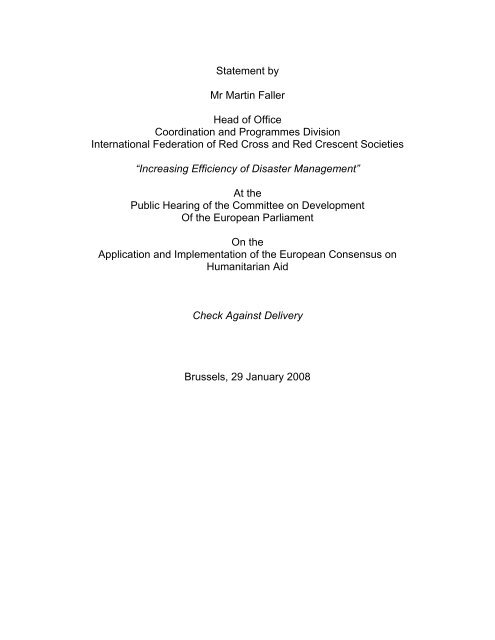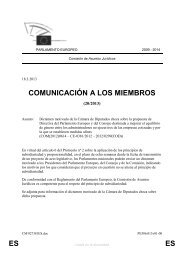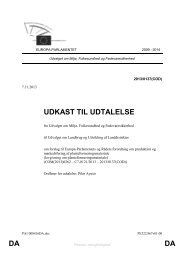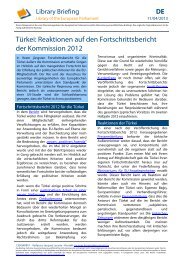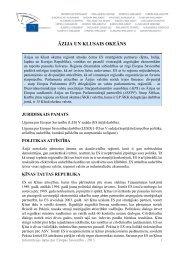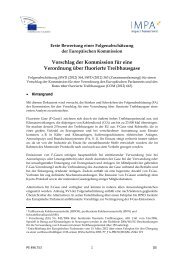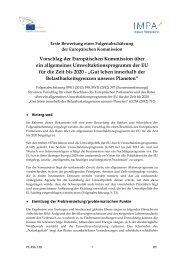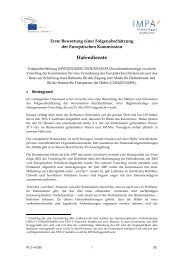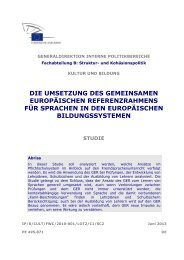Statement by Mr Martin Faller Head of Office Coordination and ...
Statement by Mr Martin Faller Head of Office Coordination and ...
Statement by Mr Martin Faller Head of Office Coordination and ...
Create successful ePaper yourself
Turn your PDF publications into a flip-book with our unique Google optimized e-Paper software.
<strong>Statement</strong> <strong>by</strong><br />
<strong>Mr</strong> <strong>Martin</strong> <strong>Faller</strong><br />
<strong>Head</strong> <strong>of</strong> <strong>Office</strong><br />
<strong>Coordination</strong> <strong>and</strong> Programmes Division<br />
International Federation <strong>of</strong> Red Cross <strong>and</strong> Red Crescent Societies<br />
“Increasing Efficiency <strong>of</strong> Disaster Management”<br />
At the<br />
Public Hearing <strong>of</strong> the Committee on Development<br />
Of the European Parliament<br />
On the<br />
Application <strong>and</strong> Implementation <strong>of</strong> the European Consensus on<br />
Humanitarian Aid<br />
Check Against Delivery<br />
Brussels, 29 January 2008
<strong>Statement</strong> <strong>by</strong> <strong>Mr</strong> <strong>Martin</strong> <strong>Faller</strong> at the Public Hearing <strong>of</strong> the Committee on<br />
Development <strong>of</strong> the European Parliament – Brussels - 29.01.08<br />
1. The International Federation closely followed the consultation process that<br />
lead to the approval <strong>of</strong> "The European Consensus on Humanitarian Aid”. The<br />
International Federation <strong>and</strong> its European member National Red Cross<br />
Societies – appreciate the possibility to participate in the consultation process<br />
<strong>and</strong> consider the Consensus as a highly valuable document for guiding the<br />
action <strong>of</strong> the EU. We are looking forward to continue this cooperation in the<br />
application <strong>and</strong> implementation <strong>of</strong> the Consensus.<br />
2. The Consensus addresses many important subjects which are highly welcome<br />
<strong>by</strong> the International Federation. This includes the firm commitment for<br />
humanitarian principles <strong>and</strong> compliance with International Humanitarian Law<br />
(IHL), the provision <strong>of</strong> needs-based emergency response, the support to<br />
capacity building activities to prevent <strong>and</strong> mitigate impact <strong>of</strong> disasters, the<br />
emphasis on partnership, the need to take into account where possible, long<br />
term development objectives, the protection <strong>of</strong> the humanitarian space <strong>and</strong> the<br />
value <strong>of</strong> good donor practice, the issue <strong>of</strong> speed <strong>and</strong> quality in the effective<br />
delivery <strong>of</strong> humanitarian aid <strong>and</strong> the positive note on International Disaster<br />
Response Laws, Rules <strong>and</strong> Principles (IDRL), the recognition <strong>of</strong> the reduction<br />
<strong>of</strong> risk <strong>and</strong> vulnerability through enhanced preparedness, as well as the<br />
importance which the EU gives to the development <strong>of</strong> the collective global<br />
capacity to respond to humanitarian crises <strong>and</strong> not to duplicate existing<br />
international mechanisms.<br />
3. Let me focus on two very important elements <strong>of</strong> the Consensus: the<br />
support for IDRL <strong>and</strong> the building <strong>of</strong> local capacities – both are<br />
contributing to increasing efficiency <strong>of</strong> disaster management.<br />
4. International Disaster Response Laws, Rules <strong>and</strong> Principles (IDRL):<br />
Our finding is that while there has been a number <strong>of</strong> important improvements<br />
at the international level in recent years – including the Good Humanitarian<br />
Donorship Principles, the humanitarian cluster system, <strong>and</strong> the Oslo<br />
Guidelines as emphasized <strong>by</strong> the Consensus – the role <strong>of</strong> the government in<br />
affected states has been neglected. Few states have detailed laws <strong>and</strong><br />
mechanisms in place for facilitating international relief. As a result, we see<br />
unnecessary bureaucratic bottlenecks <strong>and</strong> a lack <strong>of</strong> effective monitoring <strong>of</strong> the<br />
quality <strong>and</strong> coordination <strong>of</strong> international assistance.<br />
5. For example, in several states affected <strong>by</strong> the 2004 tsunami, hundreds <strong>of</strong><br />
containers <strong>of</strong> relief goods were stuck in customs for months. Humanitarian<br />
personnel were required to repeatedly fly in <strong>and</strong> out <strong>of</strong> the affected countries<br />
to renew visas. At the same time, there <strong>and</strong> in other recent disasters,<br />
inappropriate <strong>and</strong> unnecessary goods <strong>and</strong> interventions from the international<br />
community posed a great burden on local <strong>of</strong>ficials <strong>and</strong> National Red Cross <strong>and</strong><br />
Red Crescent Societies <strong>and</strong> sometimes represented an affirmative danger to<br />
disaster-affected persons.<br />
6. To address these kinds <strong>of</strong> problems, the International Federation led a global<br />
collaborative process to develop the “Guidelines for the domestic facilitation<br />
<strong>and</strong> regulation <strong>of</strong> international disaster relief <strong>and</strong> initial recovery assistance.”<br />
The IDRL Guidelines were unanimously adopted <strong>by</strong> states <strong>and</strong> the<br />
2
<strong>Statement</strong> <strong>by</strong> <strong>Mr</strong> <strong>Martin</strong> <strong>Faller</strong> at the Public Hearing <strong>of</strong> the Committee on<br />
Development <strong>of</strong> the European Parliament – Brussels - 29.01.08<br />
components <strong>of</strong> the International Red Cross <strong>and</strong> Red Crescent Movement at its<br />
30 th International Conference in November 2007. EU member states <strong>and</strong><br />
European National Red Cross Societies made joint pledges at the Conference<br />
with regard to following up with the Guidelines.<br />
7. We strongly recommend that the implementation plans for the<br />
Consensus will include support for the dissemination <strong>and</strong> promotion <strong>of</strong><br />
the IDRL Guidelines, both within the EU <strong>and</strong> in the states where it<br />
provides assistance.<br />
8. Building local capacities:<br />
While continuously optimising our international response capabilities, we are<br />
giving highest importance to increase local community, civil society <strong>and</strong> Red<br />
Cross Red Crescent capacity to address the most urgent situations <strong>of</strong><br />
vulnerability. Wherever we work we are benefiting from local knowledge <strong>and</strong><br />
the many volunteers <strong>of</strong> National Red Cross <strong>and</strong> Red Crescent Societies <strong>and</strong><br />
the support from regionally <strong>and</strong> internationally active national societies<br />
(including many European National Societies) cooperating in alliances with our<br />
colleagues in the affected countries.<br />
9. For example: The global measles Initiative – a partnership led <strong>by</strong> the American<br />
Red Cross, the United Nations Foundation, UNICEF, the U.S. Center for<br />
Disease Control <strong>and</strong> Prevention, <strong>and</strong> WHO connecting many international<br />
supporters with governments <strong>and</strong> local partners in over 50 countries - with<br />
global <strong>and</strong> local impact: between 2001 <strong>and</strong> 2006, measles deaths had<br />
dropped globally <strong>by</strong> 68 percent <strong>and</strong> in Africa, <strong>by</strong> more than 91 percent. Since<br />
2001, 40 National Red Cross <strong>and</strong> Red Crescent Societies have been able to<br />
support measles campaigns with 80,000 volunteers – who are the main<br />
connectors to the communities at risk. By the end <strong>of</strong> 2006, these campaigns<br />
reached more than 240 million children.<br />
10. For example: Across West Africa <strong>and</strong> Morocco, the effects <strong>of</strong> complex<br />
emergencies, sudden <strong>and</strong> slow onset disasters such as drought, famine <strong>and</strong><br />
desertification dem<strong>and</strong> more resources <strong>and</strong> presence from our national Red<br />
Cross <strong>and</strong> Red Crescent Societies <strong>and</strong> their volunteers. Migration in this<br />
region is increasing <strong>and</strong> migrants are trying to reach the coast <strong>of</strong> Spain <strong>and</strong><br />
other European countries. We are working in alliances between African <strong>and</strong><br />
European partners <strong>and</strong> one <strong>of</strong> the most important elements <strong>of</strong> this<br />
collaboration is the enhancement <strong>of</strong> the capacities <strong>of</strong> our African partners to<br />
work on the spot with the affected communities <strong>and</strong> to strengthen national <strong>and</strong><br />
regional disaster response teams.<br />
11. For example: Only three weeks ago, the Mozambique Red Cross Society<br />
concentrated all its forces in the north <strong>of</strong> the country to fight another major<br />
flood disaster. This year compared to the 2001 flood, deaths have so far been<br />
recorded in much lower numbers. A combination <strong>of</strong> resettlement, prompt<br />
evacuation readiness <strong>and</strong> overall preparedness works. This year’s floods<br />
operation further proves the impact <strong>of</strong> community based early warning <strong>and</strong> risk<br />
reduction – however, the major flood is still to be expected, it has not yet<br />
arrived!<br />
3
<strong>Statement</strong> <strong>by</strong> <strong>Mr</strong> <strong>Martin</strong> <strong>Faller</strong> at the Public Hearing <strong>of</strong> the Committee on<br />
Development <strong>of</strong> the European Parliament – Brussels - 29.01.08<br />
12. For example: Only three months ago Cyclone Sidr devastated parts <strong>of</strong><br />
Bangladesh <strong>and</strong> caused terrible destruction. It is important to remember that<br />
while 3,300 people lost their lives in the Cyclone Sidr, the cyclone’s power was<br />
such that the death toll could easily have matched the 500,000 people who<br />
died in a very similar cyclone in 1970. In the years since the 1970 cyclone,<br />
massive operations have been conducted <strong>by</strong> the Bangladesh Red Crescent<br />
Society, the government <strong>of</strong> Bangladesh <strong>and</strong> many other actors in risk<br />
reduction. Over 650,000 people were evacuated to Cyclone Shelters, many <strong>of</strong><br />
which are built <strong>and</strong> managed <strong>by</strong> the Bangladesh Red Crescent Society.<br />
13. For example: During the Rasht earthquake operation in July 2007 in Tajikistan,<br />
local disaster response committees responded within 3.5 hrs, <strong>and</strong> national<br />
response teams were on the spot within 5.5 hrs, government aid came into the<br />
disaster zone two days later. The intervention was not just fast, but also<br />
qualified as appropriate.<br />
It is interesting to note that in Tajikistan a disaster risk management<br />
partnership worked as a permanent coordination mechanism (REACT - Rapid<br />
Emergency Assessment <strong>and</strong> <strong>Coordination</strong> Team), involving government <strong>and</strong><br />
specialized national agencies, NGOs, donors <strong>and</strong> the UN system. Five<br />
sectoral sub-groups were established following the cluster model (food, non<br />
food items <strong>and</strong> shelter, health, education <strong>and</strong> water <strong>and</strong> sanitation).<br />
14. From villages to capital cities, we need to build the capacity <strong>of</strong> communities<br />
<strong>and</strong> to prepare <strong>and</strong> help themselves. More attention needs to be paid to<br />
improving national <strong>and</strong> regional preparedness <strong>and</strong> contingency planning,<br />
particularly for natural disasters, with the full involvement <strong>of</strong> national<br />
authorities, the UN, the Red Cross <strong>and</strong> Red Crescent, NGOs <strong>and</strong> civil society.<br />
International capacity for early warning, international coordination <strong>and</strong> rapid<br />
deployment remains crucial – but it has to be better connected with local <strong>and</strong><br />
regional resources.<br />
15. Climate change is expected to lead to an increase in the frequency <strong>and</strong>/or<br />
severity <strong>of</strong> extreme weather events like heat waves, floods, droughts <strong>and</strong><br />
tropical cyclones, <strong>and</strong> the spread <strong>of</strong> diseases such as malaria <strong>and</strong> dengue.<br />
Looking back over the past three decades, we can see a dramatic increase in<br />
the number <strong>of</strong> weather related disasters. Between 2004 <strong>and</strong> 2007, the number<br />
<strong>of</strong> emergencies that the International Federation responded to increased from<br />
278 to 509 per year.<br />
16. We strongly recommend that the implementation plans for the<br />
Consensus will include further support <strong>of</strong> the international community to<br />
strengthen local, national <strong>and</strong> regional capacities for disaster<br />
management. The International Federation stresses the need to enhance the<br />
ability <strong>of</strong> local communities, civil society <strong>and</strong> the Red Cross <strong>and</strong> Red Crescent<br />
to deal not only with response but also with extreme vulnerability. This may be<br />
the most viable way <strong>of</strong> reducing the number <strong>of</strong> deaths, injuries, illnesses <strong>and</strong><br />
overall impact <strong>of</strong> disasters, diseases <strong>and</strong> public health emergencies at a time<br />
when climate change threatens increasing humanitarian crises.<br />
4


